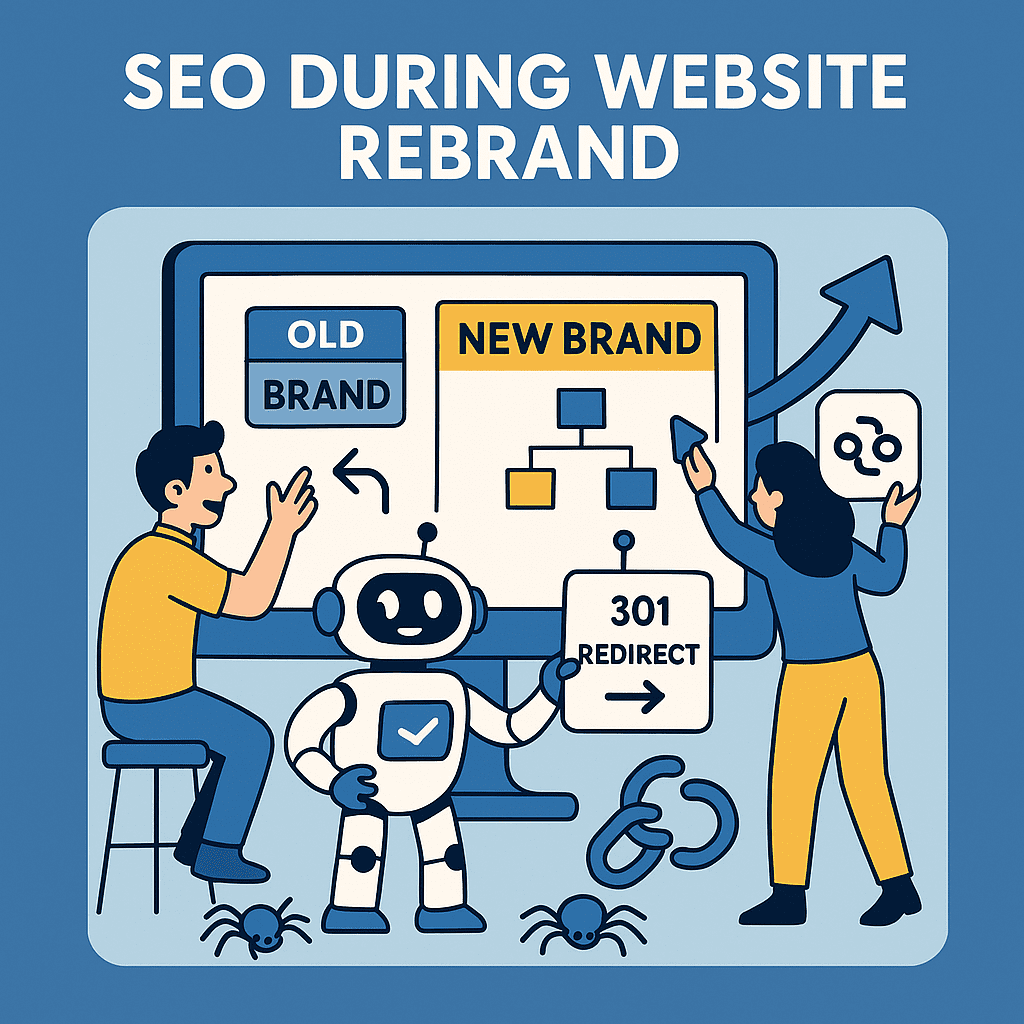SEO and Website Rebrands: Protect Rankings & Traffic
🧭 A complete roadmap to protect rankings and visibility when changing your brand
🔄 Rebrand Without Losing Your Rankings — Here’s How
Rebranding your website can feel like a fresh start—new colours, new messaging, a new identity. But if you ignore SEO during the process, it could also mean disappearing from Google’s search results overnight.
In this guide, we’ll walk you through how to handle a website rebrand without destroying your hard-earned rankings, traffic, and domain authority. Whether you’re changing your site’s layout, structure, or domain, this is the SEO survival guide every business needs.
⚠️ Why SEO Can Suffer During a Rebrand
- 🔁 Changes to URL structure that break backlinks or confuse crawlers
- 🗺️ Altered navigation or architecture that reduces internal linking strength
- 📄 Missing or outdated metadata during content migration
- 🚫 Lack of redirects for old pages that still attract traffic
- 🤖 Forgetting to remove noindex tags on new builds
🛠️ Step 1: Plan SEO from Day One
- 📝 Audit your current site’s performance (top pages, backlinks, keywords)
- 📌 Document all meta titles, descriptions, and heading structures
- 📈 Benchmark rankings and traffic using tools like Google Search Console and Ahrefs
- 📄 Create a sitemap of existing URLs
This data becomes your blueprint—so you don’t lose what’s already working.
📂 Step 2: Keep URLs Consistent (If Possible)
Where possible, keep your existing URLs unchanged. If URLs must change:
- 🔗 Use 301 redirects from old to new URLs
- 📄 Update internal links site-wide to point to new URLs
- 🔍 Submit a new sitemap to Google Search Console
📦 Step 3: Use a Development Environment
- 🛠️ Build the new version of your site on a staging domain (e.g. dev.yoursite.com)
- 🔐 Block search engines using robots.txt or password protection
- ✅ Thoroughly test redirects, page speed, and mobile friendliness
This prevents unfinished versions from being indexed or ranked prematurely.
🔎 Step 4: Preserve On-Page SEO Elements
- 📑 Carry over title tags, meta descriptions, H1s, and internal links
- 🧱 Maintain schema markup, alt text, and Open Graph data
- 🔍 Optimise new pages for their target keywords
📊 Step 5: Map and Implement Redirects
- 🔁 Create a redirect map of old URLs to new ones
- 🧠 Match content as closely as possible (home-to-home, service-to-service)
- ⚠️ Avoid redirect chains or loops
Use a plugin like Redirection (WordPress) or your .htaccess file/server config to implement them.
📣 Step 6: Communicate the Change
- 📢 Announce the rebrand on social media and email
- 🔗 Update external links where you can (directories, partners, PR mentions)
- 🧭 Ask high-authority referrers to update their links
📈 Step 7: Monitor Post-Launch SEO Performance
- 📊 Watch Google Search Console for crawl errors and indexing issues
- 🔍 Use Ahrefs or SEMrush to monitor rankings and traffic changes
- 🚦 Prioritise fixing broken links, slow pages, or redirects that fail
Give Google 4–6 weeks to fully process changes before panicking about rankings.
🚫 Common Mistakes to Avoid
- ❌ Forgetting to remove “noindex” or “disallow” directives post-launch
- ❌ Using 302 (temporary) redirects instead of 301s
- ❌ Deleting old pages without redirects
- ❌ Assuming your domain authority will transfer automatically
💬 What the Experts Are Saying
- Marie Haynes: “Many sites lose years of SEO equity during a rebrand—not because they rebrand, but because they don’t prepare properly.”
- Barry Adams: “301 redirects are not optional—they’re your safety net.”
- John Mueller (Google): “Changing URLs without redirects is the SEO equivalent of erasing your business address.”
✅ Conclusion
A rebrand can supercharge your business—but it must be done with SEO in mind. By planning early, preserving structure, and redirecting correctly, you can refresh your identity without losing visibility or traffic.
Remember, SEO is not just about ranking—it’s about continuity, trust, and making sure your audience can still find you, even if you’ve changed your name.
📝 Recap and Clarify: Post-Specific FAQs
Can a website rebrand affect my SEO?
Yes. A rebrand can disrupt your rankings if not handled properly—especially if you’re changing domains, site structure, or content. Planning is key to avoid losing SEO equity.
What’s the first SEO step when planning a rebrand?
Start by creating a complete backup of your current website, including URLs, metadata, content, and backlinks. You’ll need this to compare performance and map redirects accurately.
Should I change my domain name when rebranding?
Only if it’s absolutely necessary. Domain changes can cause temporary ranking drops, so ensure 301 redirects and proper Search Console updates are in place if you go ahead.
How do 301 redirects protect SEO during a rebrand?
301 redirects tell search engines that a page has permanently moved. This helps transfer link equity and prevents visitors from landing on broken or outdated URLs.
Do I need to update my sitemap and robots.txt?
Yes. After a rebrand, update your sitemap to reflect new URLs and make sure your robots.txt file isn’t blocking important pages or resources from being crawled.
What tools help track SEO performance after a rebrand?
Use Google Search Console, Google Analytics, and keyword tracking tools like Ahrefs or Semrush to monitor traffic drops, indexing issues, and ranking changes post-relaunch.
Should I tell Google about my site move?
Yes. If you’re changing domains, use the “Change of Address” tool in Google Search Console to notify Google and speed up the transition in search results.
What happens if I skip SEO planning during a rebrand?
You risk losing rankings, traffic, and backlinks. Pages may disappear from Google, or users may hit 404 errors. Recovery can take months if the process is mishandled.
How long does it take for SEO to stabilise after a rebrand?
It varies. If redirects and technical changes are done correctly, rankings can stabilise within 2–6 weeks. Major domain changes may take longer for full recovery.
Can I improve my SEO during a rebrand?
Yes! A rebrand is the perfect time to fix old issues—like site speed, structure, mobile-friendliness, and content gaps—while ensuring your SEO foundation is stronger than before.
A website rebrand without SEO is like changing your name and forgetting to tell anyone. – David Roche


















